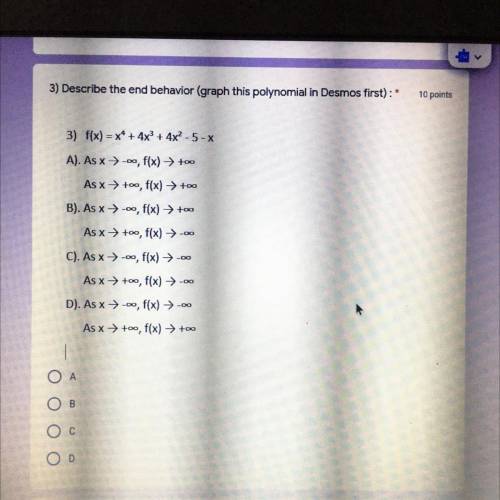
Mathematics, 14.05.2021 02:00, taibamah
Please help
3) Describe the end behavior (graph this polynomial in Desmos first) : *
3) f(x) = x* + 4x² + 4x2 - 5 - X
A). As x→--, f(x) → +
As x → too, f(x) → too
B). As x → --, f(x) → too
As x → too, f(x) > --
C). As x → --, f(x) > --
As x → too, f(x) = -~
D). As x → --o, f(x) →-00
As x → too, f(x) → too


Answers: 2
Other questions on the subject: Mathematics

Mathematics, 20.06.2019 18:04, hsjsjsjdjjd
Grandma made an apple pie. josh and his brother joe finished 4/5 of it. then 3 friends came over and shared the left over. how much pie did each friend eat
Answers: 2

Mathematics, 21.06.2019 16:00, heids17043
Select all the correct answers. what is 221,000,000,000,000,000,000 expressed in scientific notation?
Answers: 2

Mathematics, 21.06.2019 16:30, eliascampos823
Which choice represents the sample space ,s for this event
Answers: 3

Mathematics, 21.06.2019 22:00, johnlumpkin5183
Aprofessional hockey team has noticed that, over the past several seasons, as the number of wins increases, the total number of hot dogs sold at the concession stands increases. the hockey team concludes that winning makes people crave hot dogs. what is wrong with the hockey team's conclusion? a) it does not take into account the attendance during each season. b) it does not take into account the number of hamburgers sold during each season. c) it does not take into account the number of concession stands in the hockey arena. d) it does not take into account the number of seasons the hockey team has been in existence.
Answers: 1
Do you know the correct answer?
Please help
3) Describe the end behavior (graph this polynomial in Desmos first) : *
3) f(x)...
3) f(x)...
Questions in other subjects:








Mathematics, 23.01.2020 17:31


History, 23.01.2020 17:31






